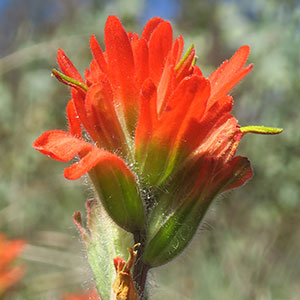Castilleja brevilobata
Castilleja campestris
short-lobed paintbrush
field owl's-clover, meadow paintbrush, vernal pool Indian paintbrush, yellow owl's clover
solitary or few, erect or ascending, unbranched, sometimes branched, hairs spreading, short, medium, and long, soft, short and medium ones short stipitate-glandular.
solitary or few, erect, unbranched, sometimes branched, glabrous or hairs sparse proximally, spreading, long, soft distally.
green or ± yellow, lanceolate, elliptic, or oblong to narrowly ovate, 1–2(–2.5) cm, not fleshy, margins plane or wavy, involute, (0–)3–5(–7)-lobed, apex rounded to acute;
lobes ascending to erect, linear to lanceolate, apex rounded to acute.
green, sometimes purple-tinged, linear to narrowly lanceolate, (0.4–)1–4 cm, not fleshy, thin and flexible or thick and ± brittle, margins plane, involute, 0-lobed, apex acuminate.
3–20 × 2–3.5 cm;
bracts proximally greenish to dull brown, distally red, orange-red, or scarlet, sometimes orange or yellow, broadly lanceolate or oblong, (0–)3–5-lobed;
lobes ascending, broadly to narrowly lanceolate, short, arising above mid length, apex acute, obtuse, or rounded.
2–15 × 2–3 cm;
bracts green throughout, sometimes purplish tinged, linear to narrowly lanceolate, 0-lobed, apex acute.
straight, 15–24(–26) mm;
tube 12–16 mm;
beak exserted, abaxial lip equal to calyx;
beak adaxially green or ± yellow-green, 7–10 mm, puberulent, stipitate-glandular;
abaxial lip deep green, reduced, rounded, 1–2 mm, 10–25% as long as beak;
teeth incurved to erect, light green, 0.5–1 mm.
straight, 11–26 mm;
tube 10–22 mm;
abaxial lip, beak, and part of tube exserted from calyx;
beak adaxially white or yellow, 3–6 mm;
abaxial lip yellow, sometimes orange, paler near teeth, prominent, deeply saccate with 3 lobes at ca. 90° from one another, pouches 6–10 mm wide, 3–4 mm deep, abruptly widening from tube, sacs ± round or ± rounded-triangular from above, villous within at base of teeth, 4–5 mm (2–4 mm from sinus), 70–90% as long as beak, puberulent;
teeth erect, white, sometimes with deeply colored bases, 0.5–2 mm.
green or whitish with green veins, lobes colored as bract lobes or paler, 14–30 mm;
abaxial and adaxial clefts 5.5–8.5 mm, 30–40% of calyx length, deeper than laterals, lateral 1.5–4 mm, 20–25% of calyx length;
lobes oblong to narrowly triangular, apex obtuse to rounded.
proximally green, pale, or purplish, distally purple or green, 5.5–11 mm;
abaxial and adaxial clefts 2–5 mm, 30–50% of calyx length, deeper than laterals, lateral 1.5–2.5 mm, 25–30% of calyx length;
lobes linear-lanceolate to narrowly triangular, apex acute to acuminate.
= 24.
= 24.
Castilleja brevilobata
Castilleja campestris
Castilleja brevilobata is endemic to dry serpentine openings in the Siskiyou Mountains of southwestern Oregon and adjacent California. Although sometimes treated as part of C. applegatei or C. hispida, its morphology does not suggest a close connection with either. This species occasionally hybridizes with C. pruinosa in Del Norte County, California.
(Discussion copyrighted by Flora of North America; reprinted with permission.)
Varieties 2 (2 in the flora).
Castilleja campestris is sometimes confused with Triphysaria eriantha subsp. eriantha, but C. campestris has two-celled anthers and entire leaves, while T. eriantha has one pollen sac per stamen and strongly divided leaves.
(Discussion copyrighted by Flora of North America; reprinted with permission.)
1. Leaves and bracts linear; leaves thin, flexible; bracts shorter than or ± equal to flowers; corollas light to bright yellow; proximal pollen sacs to 1/3 length of distal. | var. campestris |
1. Leaves and bracts lanceolate; leaves thick, ± brittle; bracts longer than flowers; corollas usually yellow to orange; proximal pollen sacs ca. 1/2 length of distal. | var. succulenta |


